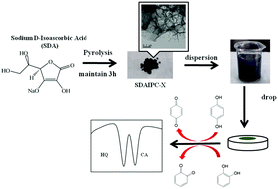Direct synthesis of highly porous interconnected carbon nanosheets from sodium d-isoascorbic acid for the simultaneous determination of catechol and hydroquinone†
Abstract
Three-dimensional interconnected porous carbon nanosheets were prepared through pyrolyzing sodium D-isoascorbic acid, and were thoroughly characterized by scanning electron microscopy (SEM), transmission electron microscopy (TEM) and X-ray diffraction (XRD). The specific surface area and pore size distribution of the porous carbon nanosheets were characterized by N2 adsorption desorption. The thickness of the carbon nanosheet was measured by atomic force microscopy (AFM). An electrochemical sensor was fabricated by the modification of the porous carbon nanosheets onto a glassy carbon electrode surface. The electrochemical behaviors of hydroquinone (HQ) and catechol (CA) on the electrochemical sensor were investigated by cyclic voltammetry and differential pulse voltammetry. Under the optimized conditions, the peak currents were found to be linear to the HQ and CA concentrations in the range from 0.4 to 20 μmol L−1, and the detection limits were 0.028 μmol L−1 (HQ) and 0.035 μmol L−1 (CA), respectively.



 Please wait while we load your content...
Please wait while we load your content...